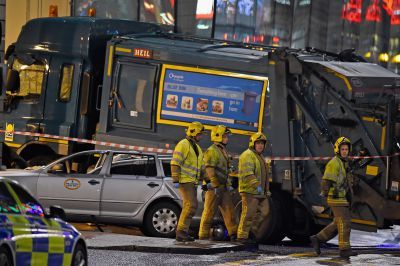
THE DVLA is set to overhaul its rules on drivers with health problems following the Glasgow bin lorry tribunal.
The UK’s driving authority is to conduct a widespread review of how they carry out checks on drivers applying for and renewing licences after the Fatal Accident Inquiry ends.
Road safety campaigners want to see a move away from the current self-check system with drivers forced to hand over their medical history to the organisation when applying for a licence.
It follows weeks of testimony relating to bin lorry driver Harry Clarke’s apparent health problems.
DVLA experts have already said they are to review the way they deal with drivers with medical issues. And now the body has said a review is to happen after the end of the FAI.
The inquiry at Glasgow Sheriff Court has heard that Mr Clarke, 58, repeatedly lied about his blackouts to the DVLA, medics and his employers.
Motoring bodies say the technology exists already to make it possible to weed out drivers who should not be behind the wheel.
Neil Greig, of the Institute of Advance Motoring, said: “We would like to see a central database of the medical records of all drivers on our roads for the DVLA. I think that is the minimum of what we should expect.
“We have an ageing population and the health problems of our drivers are only going to get worse.”
The FAI into the death of six people in Glasgow on December 22, 2014, has heard how Mr Clarke who was unconscious at the wheel of the bin lorry when it crashed had a history of health problems dating back 40 years.
He suffered from vertigo, dizziness and blackouts.
The inquiry has heard how he lied to the DVLA about one blackout he suffered while working for First Bus in 2010.
Now, the DVLA which revealed last week it would not be pursuing a prosecution of Mr Clarke in England and Wales for giving wrong information is set for a root-and-branch revision of its fitness-to-drive rules.
It comes after the DVLA’s senior medical officer Dr Wyn Parry told the FAI last week the current system was too heavy on “self-notification” and open to abuse.
He added the inquiry had sparked the authority into reviewing its guidelines.
He said it would look at driving rules given to medical practitioners with GPs expected to play a bigger role in licence paperwork.
Last night, a spokesman for the DVLA confirmed the body was to review the current fitness-to-drive rules after the inquiry ended.
He said: “We will be very carefully considering the recommendations made by the sheriff in relation to this FAI.”
The inquiry had heard how a heavy goods driver can dodge disclosing their medical problems during the renewal period by going to their company’s doctor instead of their GP for their check-ups.
The inquiry even heard last week how Clarke could have been back driving HGVs if the hearing had not started when it did.
DVLA senior medical adviser Dr Gareth Parry told the hearing that the agency had rubber-stamped the return of Mr Clarke’s licence in April.
The decision was only revoked in June after the DVLA received further medical evidence about the 2010 blackout he suffered.
The information was gathered by the DVLA’s own lawyers ahead of the inquiry.
The form filled out by Clarke earlier this year asking for his licence back mentioned the George Square tragedy yet again failed to divulge the collapse behind the wheel of the bus.
Neil Greig said “when someone’s livliehood is at stake” it is possible to “abuse that system” resulting in “horrendous repercussions”.
Under the current system, car drivers’ licences are valid until the age of 70, unless a medical reason prevents an individual from driving.
After 70, drivers need to renew their licence every three years.
Lorry and bus drivers need to renew their licence every five years after reaching 45.
After the age of 65 they must renew it every year.
All licence applications require a medical self-declaration by the applicant.
Solicitor advocate and road traffic specialist lawyer, Richard Freeman, of Richard Freeman & Company, said the current self-reporting system was based on the goodwill of drivers.
He said: “If the DVLA is keen to end this practice it should increase the levels of sanctions against drivers who lie to them.
“If justice is seen to be swift and tough, it acts as a suitable deterrent to drivers.”
The inquiry last week heard the Crown reiterate its stance that no legal action is to be taken against Clarke.
The decision has angered victims’ families, who have been asked by the sheriff if they intend to bring a private prosecution.
Jack Sweeney, 68, his wife Lorraine, 69, and their 18-year-old granddaughter Erin McQuade, all from Dumbarton, died when the bin lorry hit them.
Gillian Ewing, 52, from Edinburgh, Jacqueline Morton, 51, and 29-year-old Stephanie Tait, from Glasgow, also lost their lives.
The inquiry continues.
WHAT DO YOU THINK?
Do you think there should be tougher checks on drivers with health problems? Let us know your views by calling 0141 567 2812 or emailing mail@sundaypost.com

Enjoy the convenience of having The Sunday Post delivered as a digital ePaper straight to your smartphone, tablet or computer.
Subscribe for only £5.49 a month and enjoy all the benefits of the printed paper as a digital replica.
Subscribe